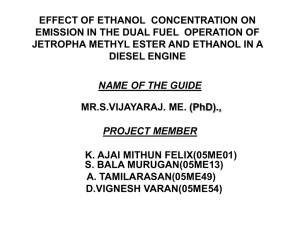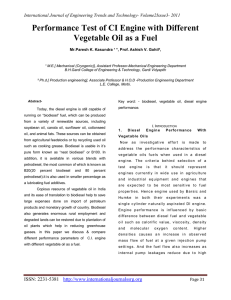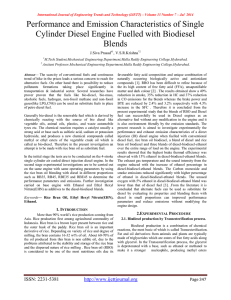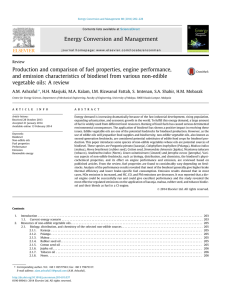Document 14098682
advertisement
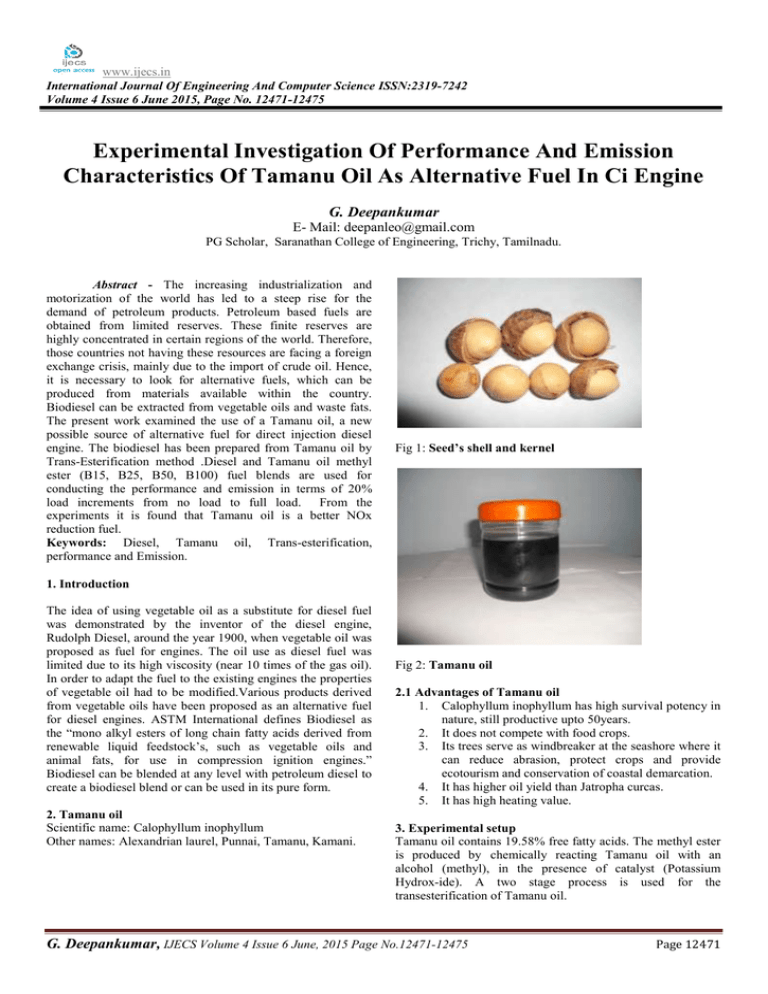
www.ijecs.in International Journal Of Engineering And Computer Science ISSN:2319-7242 Volume 4 Issue 6 June 2015, Page No. 12471-12475 Experimental Investigation Of Performance And Emission Characteristics Of Tamanu Oil As Alternative Fuel In Ci Engine G. Deepankumar E- Mail: deepanleo@gmail.com PG Scholar, Saranathan College of Engineering, Trichy, Tamilnadu. Abstract - The increasing industrialization and motorization of the world has led to a steep rise for the demand of petroleum products. Petroleum based fuels are obtained from limited reserves. These finite reserves are highly concentrated in certain regions of the world. Therefore, those countries not having these resources are facing a foreign exchange crisis, mainly due to the import of crude oil. Hence, it is necessary to look for alternative fuels, which can be produced from materials available within the country. Biodiesel can be extracted from vegetable oils and waste fats. The present work examined the use of a Tamanu oil, a new possible source of alternative fuel for direct injection diesel engine. The biodiesel has been prepared from Tamanu oil by Trans-Esterification method .Diesel and Tamanu oil methyl ester (B15, B25, B50, B100) fuel blends are used for conducting the performance and emission in terms of 20% load increments from no load to full load. From the experiments it is found that Tamanu oil is a better NOx reduction fuel. Keywords: Diesel, Tamanu oil, Trans-esterification, performance and Emission. Fig 1: Seed’s shell and kernel 1. Introduction The idea of using vegetable oil as a substitute for diesel fuel was demonstrated by the inventor of the diesel engine, Rudolph Diesel, around the year 1900, when vegetable oil was proposed as fuel for engines. The oil use as diesel fuel was limited due to its high viscosity (near 10 times of the gas oil). In order to adapt the fuel to the existing engines the properties of vegetable oil had to be modified.Various products derived from vegetable oils have been proposed as an alternative fuel for diesel engines. ASTM International defines Biodiesel as the “mono alkyl esters of long chain fatty acids derived from renewable liquid feedstock’s, such as vegetable oils and animal fats, for use in compression ignition engines.” Biodiesel can be blended at any level with petroleum diesel to create a biodiesel blend or can be used in its pure form. 2. Tamanu oil Scientific name: Calophyllum inophyllum Other names: Alexandrian laurel, Punnai, Tamanu, Kamani. Fig 2: Tamanu oil 2.1 Advantages of Tamanu oil 1. Calophyllum inophyllum has high survival potency in nature, still productive upto 50years. 2. It does not compete with food crops. 3. Its trees serve as windbreaker at the seashore where it can reduce abrasion, protect crops and provide ecotourism and conservation of coastal demarcation. 4. It has higher oil yield than Jatropha curcas. 5. It has high heating value. 3. Experimental setup Tamanu oil contains 19.58% free fatty acids. The methyl ester is produced by chemically reacting Tamanu oil with an alcohol (methyl), in the presence of catalyst (Potassium Hydrox-ide). A two stage process is used for the transesterification of Tamanu oil. G. Deepankumar, IJECS Volume 4 Issue 6 June, 2015 Page No.12471-12475 Page 12471 3.1 Reagents and materials used for experiment 1.Tamanu oil for biodiesel preparation 2. Methanol 3. Acid catalyst, sulphuric acid[H2SO4] 4. Base catalyst, Potassium Hydroxide[KOH] Table 3: Engine specification Make Kirlosker TV-1 Type Vertical cylinder DI diesel engine Number of cylinder 1 Bore x Stroke 87.5 mm x 110 mm Compression ratio 17.5:1 Speed 1500 rpm Rated brake power 5.2 kw Cooling system Water Fuel Fuel injection pump Diesel Injection type MICO inline with mechanical governer and flange mounted Mechanical pump-nozzle injection system Injection pressure 220 bar Ignition timing 23ᵒbefore TDC(rated) Ignition system Compression ignition Fig 3: Trans-esterification Setup 4. Blending of Biodiesel The blending of oil with diesel is done by volume basis. Table 1 : Blending of Tamanu oil with Diesel Type of blend Amount of Amount of diesel(ml) biodiesel(ml) Diesel 1000 0 B15 850 150 B25 B50 B100 750 500 0 250 500 1000 Table 2 : Properties of Diesel and Biodiesel blends Properti Flash Fire Density Calorifi Kinematic es Point Point @ 15ᵒC c value Viscosity ᵒC ᵒC kg/m3 KJ/Kg @ 40ᵒC cSt Diesel 65 84 820 42000 3.12 B15 75 100 835 41300 3.24 B25 84 112 840 40600 3.32 B50 105 130 844 39900 3.75 B100 145 156 852 39000 4.25 5. Experimental Setup for Testing Biodiesel on Engine The setup consists of single cylinder, four strokes, Diesel engine connected to eddy current type dynamometer for loading. Using esterified Tamanu oil in the compression ignition diesel engine at a rated speed of 1,500 rpm, the performance and emission analysis is carried out. Fig 4: Engine setup 6. Performance characteristics 6.1.Brake Thermal Efficiency Brake Thermal Efficiency is defined as break power of a heat engine as a function of the thermal input from the fuel. BTE constantly increases based on the load condition. This was due to a reduction in heat loss and increase in power with increase in percent load. The maximum brake thermal efficiency obtained is about 30% for B15, which is quite higher than that of diesel. G. Deepankumar, IJECS Volume 4 Issue 6 June, 2015 Page No.12471-12475 Page 12472 Diesel B15 B50 B100 Fig 5: Brake power Vs Brake Thermal Efficiency SFC(kg/kw.hr) 6.2 Specific Fuel Consumption Specific fuel consumption, abbreviated SFC, compares the ratio of the fuel used by an engine to a certain force such as the amount of power the engine produces. Among the blend B15 is lowest at all loads which is normally the optimum for any diesel engine. Higher proportions of Tamanu oil in the blends increases the viscosity which in turn increases the specific fuel consumption due to poor atomization of fuel. 0.7 0.6 0.5 0.4 0.3 0.2 0.1 0 Diesel B15 Smoke Density (HSU) B25 1.021 2.073 3.095 4.147 5.198 Brake power(kw) B50 B100 Fig 6: Brake power Vs Specific fuel consumption 6.3 Mechanical Efficiency Figure 4 shows that B100 have higher efficiency at load condition. Diesel fuel has lag in the mechanical efficiency compared with that Biodiesel blends. This shows that the biodiesel lubricity have reduces the friction losses. 80 60 Diesel B15 40 100 80 60 Diesel 40 B15 20 B25 0 B50 20 40 60 80 100 B100 Load(%) Fig 8: Load Vs Smoke Density 7.2 Carbon Monoxide Emission The CO emission tend to increase with the increase in the load.it is observed that at low loads the CO emission for B15 and diesel were found to be same but at higher loads B15 produces more CO and this may be due to high viscosity and improper spray pattern with higher blend percentage resulting in incomplete combustion. B25 1.021 2.073 3.095 4.147 5.198 Brake power(KW) Mechanical Efficiency(%) 7. Emission characteristics 7.1 Smoke Emission It is observed from the figure 6 that Smoke Density increases with increase in Load and B100 produces more smoke at all Load condition and this may be due to lesser calorific value and high density. 0.5 CO(%by Volume) Brake thermal Efficiency(%) 35 30 25 20 15 10 5 0 0.4 Diesel 0.3 B15 0.2 B25 0.1 B50 0 B100 20 40 60 80 Load(%) 100 Fig 9: Load Vs Carbon Monoxide 7.3 Carbon Dioxide Emission Figure 7, shows the emission levels of CO2 for various blends and diesel. The Blend B15 gives less CO2 emission at full load condition. The rising trend of CO2 emission with load is due to the higher fuel entry as the load increases. B25 20 B50 0 B100 1.021 2.073 3.095 4.147 5.198 Brake power(Kw) Fig 7: Brake power Vs Mechanical Efficiency G. Deepankumar, IJECS Volume 4 Issue 6 June, 2015 Page No.12471-12475 Page 12473 NOX over the entire load range. The reduction in NOX emission is due to reduced premixed burning rate (low heat release rate) leads to lower cylinder temperature. 6 Diesel B15 4 B25 2 B50 0 B100 20 40 60 80 Load(%) 100 NOX(ppm) CO2(% by Volume) 8 Fig 10: Load Vs Carbon Dioxide Diesel B15 B25 B50 B100 20 7.4 Oxygen Emission It has been noted that Oxygen emission tend to decrease with the increase in the load and this may be due to more consumption of oxygen in the combustion chamber. 20 O2(%by Volume) 1400 1200 1000 800 600 400 200 0 15 Diesel B15 10 B25 5 40 60 80 Load(%) 100 Fig 13: Load Vs Oxides of Nitrogen 7.7 Exhaust Gas Temperature The exhaust gas temperature tend to increase with increase in the brake power. The exhaust gas temperature reflects on the status of combustion inside the combustion chamber. It is observed from the graph that all blends gives low exhaust gas temperature when compared to that of diesel. The diesel gives higher exhaust gas temperature because of its higher heat content. B50 0 500 B100 40 60 80 Load(%) 100 400 EGT(ᵒC) 20 Fig 11: Load Vs Oxygen 7.5 Hydro Carbon Emission HC emission tend to increase with the increase in the load.It has been noted that almost all blends gives higher HC emission than that of diesel and the reason for this may be due to Poor volatility and high viscosity. Diesel 300 B15 200 B25 100 B50 0 B100 20 40 60 80 Load(%) 100 Fig 14: Load Vs Exhaust Gas Temperature 120 HC(ppm) 100 Diesel 80 B15 60 B25 40 B50 20 B100 0 20 40 60 80 Load(%) Fig 12: Load Vs Hydro Carbon 100 7.6 Oxides of Nitrogen The NOX emission increased as the engine load increased, due to combustion temperature increased. This proves that the emission of NOX is significantly influenced by the cylinder gas temperature and the availability of oxygen during combustion. It is observed that all blends produces lower NOX compared to diesel over the entire load range.B100 gives less 8.Conclusion The following conclusions are drawn from the investigation: 1) Use of a non-edible oil namely Tamanu oil is considered as a new possible source of alternative fuel for diesel engine. 2) No difficulty was faced at the time of starting the engine and the engine ran smoothly over the range of engine speed. 3) The blend B15 shows marginal increase in brake thermal efficiency. 4) B100 gives greater mechanical efficiency than that of diesel because of the lubricity property of Tamanu oil and reduction in friction losses. 5) Based on the experiment it is found that Tamanu oil is a better NOx reduction fuel as all the blends of Tamanu oil gives less NOx emission when compared to that of diesel. 9. References G. Deepankumar, IJECS Volume 4 Issue 6 June, 2015 Page No.12471-12475 Page 12474 [1] Rahul Krishnaji Bawane, Nilima Baliram Gadge, Swapnil Ambhore, Aquib Shaikh “Experimental Investigation of Emission Characteristics of Calophyllum Inophyllum Linn (Honne) Oil as Alternative Fuel in CI Engine”. International Journal of Scientific & Engineering Research, Volume 5, Issue 6, June-2014 [2] Mohan T Raj and Murugu mohan Kumar K Kandasamy "Tamanu oil - an alternative fuel for variablecompression ratio engine”.International Journal of Energy and Environmental Engineering 2012, 3:18 [3] Murugan K, Udhayakumar K “ Performance and Emission Characteristics of Biodiesel using with Tamanu Oil in Single Cylinder Four Stroke Diesel Engine”. IOSR Journal of Mechanical and Civil Engineering (IOSR-JMCE) [4] B. K. Venkanna, C. Venkataramana Reddy “Performance, emission and combustion characteristics of direct injection diesel engine running on Calophyllum inophyllum linn oil (honne oil)” .Int J Agric & Biol Eng 26 March, 2011 Vol. 4 No.1 [5] I.M. Rizwanul Fattah , H.H. Masjuki, M.A. Kalam, M.A. Wakil, A.M. Ashraful, S.A. Shahir “Experimental investigation of performance and regulated emissions of a diesel engine with Calophyllum inophyllum biodiesel blends accompanied by oxidation inhibitors”. Energy Conversion and Management 83 (2014) 232–240 [6] Swarup Kumar Nayaka, Bhabani Prasanna Pattanaika, “ Experimental Investigation on Performance and Emission Characteristics of a Diesel Engine Fuelled with Mahua Biodiesel Using Additive” .4th International Conference on Advances in Energy Research 2013, ICAER 2013 [7] Bhupendra Singh Chauhan , Naveen Kumar, Haeng Muk Cho , Hee Chang Lim “A study on the performance and emission of a diesel engine fueled with Karanja biodiesel and its blends”. Energy 56 (2013) 1-7 [8] R. Sarala, M. Rajendran and S. R. Devadasan “ performance characteristics of a compression Ignition engine operated on brassica oil methyl esters” ARPN Journal of Engineering and Applied Sciences Vol. 7, no. 7, July 2012 [9] Gaurav Sharma, DevendraDandotiya, S. K. Agrawal “ Experimental Investigation of Performance Parameters of Single Cylinder IC Engine Using Mustard Oil”. International Journal of Modern Engineering Research (IJMER) Vol.3, Issue.2, March-April. 2013 [10] Shraddha R Jogdhankar, S D Rahul Bharadwaj “Alternative fuels and performance of CI-Engine running On Neem oil and bio-diesel blends”. International Journal of Environmental Science: Development and Monitoring (IJESDM) Volume 4 No. 2 (2013) [11] Intergovernmental Panel. “IPCC Fourth Assessment Report on Climate Change,2009, www.ipcc.ch”, as on 12 may 2009. [12] Energy Information administration. “International Energy Outlook.” Office of Integrated Analysis and Forecasting. U.S. Department of Energy, (2009). [13] Ministry of Petroleum and Natural gas, “Govt of India www.petroleum.nic.in./ petstat.pdf” April 20, 2009. [14] Central Pollution Control Board, “www.cpcb.nic.in” as on April 15, 2009. [15] PetersonC.L, Casada M.E, Safley L.M., Broder J.D.“Potential Production of Agriculture Produced Fuels”. Applied Engineering in Agriculture, Vol11,767-772, (1995). [16] Fukuda H, Kondo A and Noda H. “Biodiesel fuel production by Transesterification of oils”. Bioeng J Biosci, 92(5), 405–16(2001). [17] Demirbas Ayhan, “Progress and recent trends in biodiesel fuels”. Energy Conversion and Management, 14–34, 16(Oct 2008). G. Deepankumar, IJECS Volume 4 Issue 6 June, 2015 Page No.12471-12475 Page 12475
